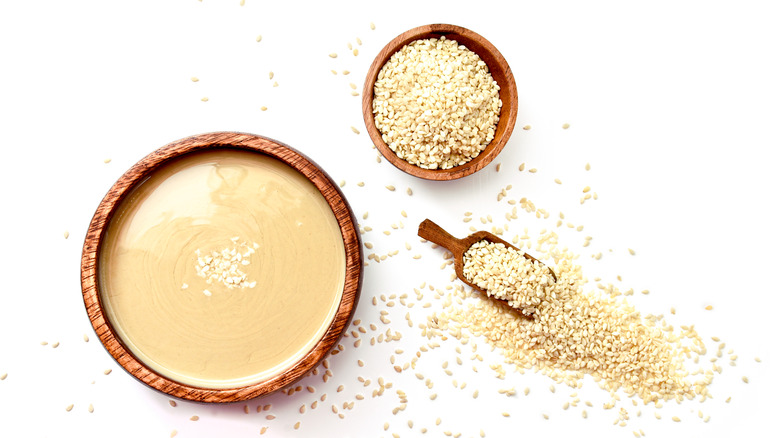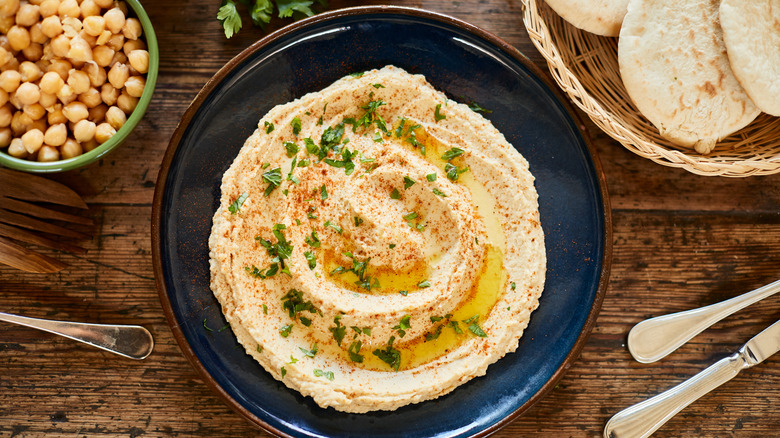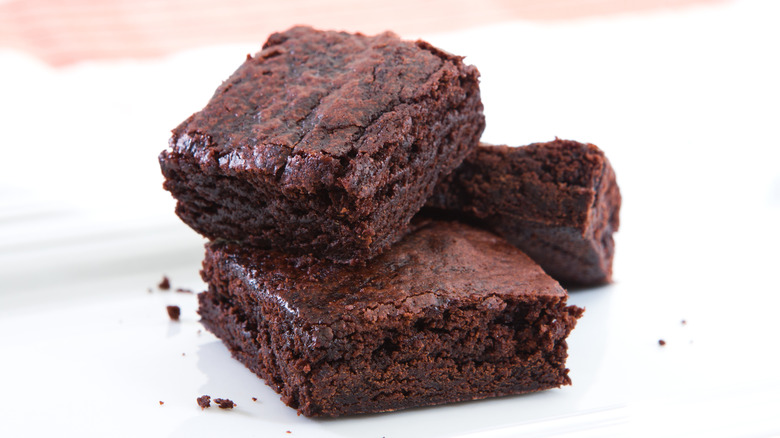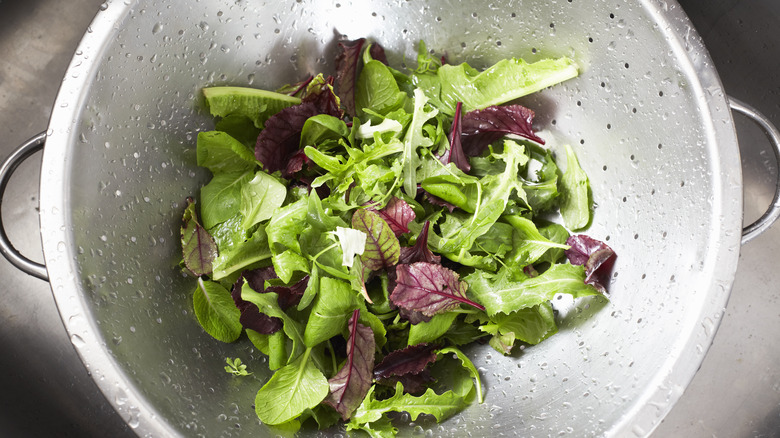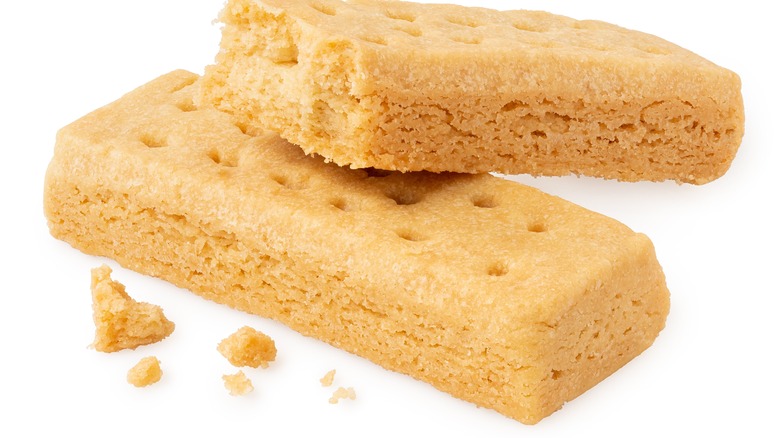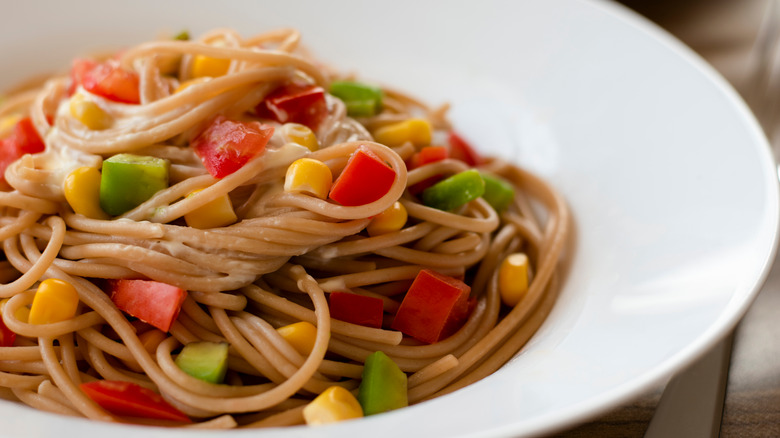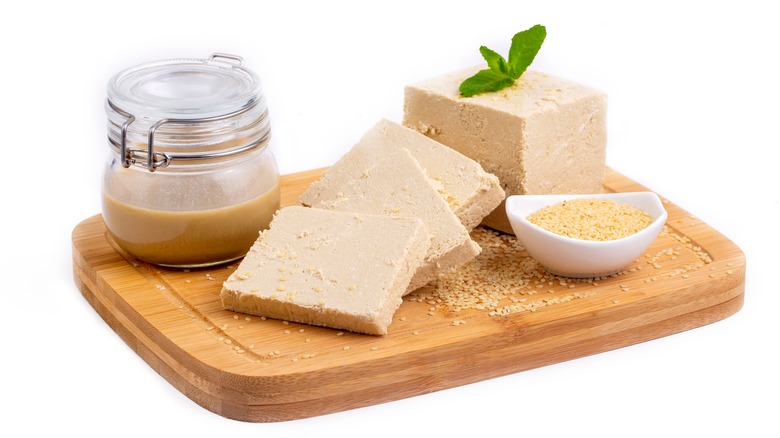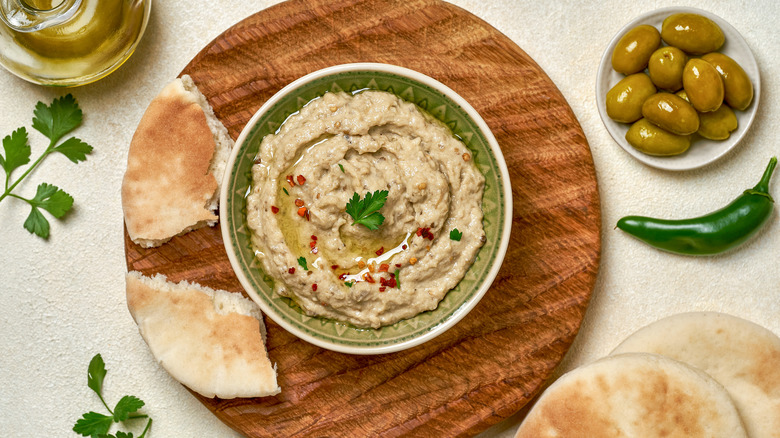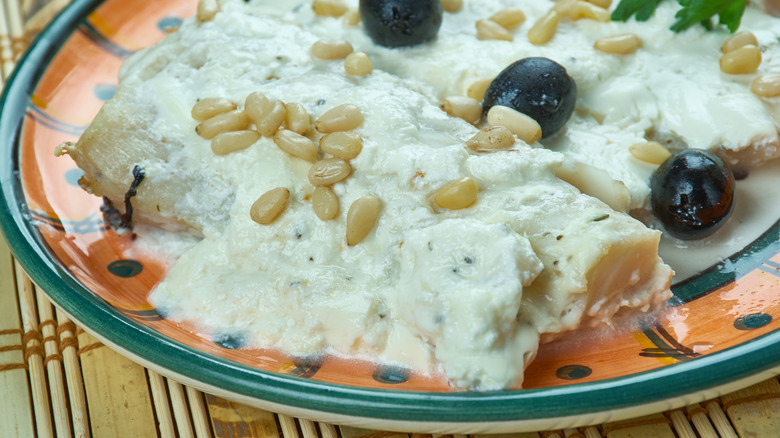10 Sweet And Savory Ways To Use Tahini
It wasn't long ago that tahini was a familiar, though relatively low profile, staple in the international foods aisle of bigger supermarkets. Most people, especially those in areas with large Middle Eastern populations, knew what it was, but it was far from a mainstream staple in most American kitchens.
But, all that has started to change. The mainstream American palate have become more adventurous, as culinary horizons broaden. Combine this with the trends towards more plant-based foods and healthier alternatives to rich dairy products, and it's easy to see how tahini — a thick, unctuous paste of crushed sesame seeds that offers mouthwatering creamy richness without the negative health effects of animal fat – has become the new it ingredient among trendy cooks. The fact that it's a powerful source of nutrition, providing calcium and other essential vitamins and minerals, doesn't hurt its case either, and neither does the fact that good-quality tahini can be downright delicious. For all these reasons, tahini has been making appearances in a lot of surprising places — here are some of the sweet and savory dishes in which you may find it.
Hummus
We'll start with the obvious: If there's any dish American cooks and eaters have always associated with tahini, it's hummus, the ancient, but now uber-trendy, dip of pureed chickpeas, tahini, and seasonings, traditionally garlic and lemon. Hummus is a staple dish and a point of pride across the Middle East. It showcases two easily available and inexpensive ingredients — chickpeas and sesame seeds (in the form of tahini) that are native to the region. Pureed chickpeas, the foundation of the dish, provide bulk and protein, while the tahini adds extra flavor and depth along with a creamy mouthfeel.
And, while tahini is by no means the dominant flavor in most varieties of hummus, the quality of the tahini used in hummus does make a big difference. So, if you're making your own hummus, be choosy about the type of tahini you use. Seek out good-quality tahini made with fresh sesame seeds (imported Lebanese brands are a good bet) and avoid any tahini in which the oil and solids have become so separated that they are difficult to recombine. Good-quality tahini will taste nutty and very slightly bitter. Old or poor-quality tahini, however, will be bitter and rancid — and these flavors will affect your finished hummus.
Brownies
Fans of chocolate-covered sesame halva know that chocolate and sesame are a terrific pairing for desserts. And in recent years, creative cooks and recipe developers have rediscovered the combo, incorporating tahini into a range of chocolaty treats ranging from tarts to cakes to brownies, an especially popular choice.
It's easy to see why tahini is a natural partner for brownies. These loving squares of indulgence are inherently rich and dense, which tahini only enhances. And, since nuts are a classic flavor accent for brownies, the inherent nuttiness of tahini is an easy fit that also offers a fresh alternative to classic additions such as chopped walnuts or pecans. Tahini can also add visual appeal to classic brownies — while it's often unobtrusively stirred into the batter, it is sometimes swirled on top of the brownie batter before baking, creating an eye-catching marbling effect.
Salad dressing
We all know a crisp, green salad is good for us. But while a classic, light vinaigrette can be refreshing on a hot day or if we're in the right mood, sometimes it doesn't feel like enough. Switching to a rich, creamy blue cheese or ranch or Thousand Island dressing is an option, but for those concerned about nutrition, the cholesterol and calories from these tasty concoctions could be problematic: What's the point of making a healthy salad only to cancel out its benefits with the dressing? You might as well order another serving of fries.
This is another place where tahini can be your friend. It's commonly used in the Middle East to make creamy sauces for vegetables and vegetable-based preparations such as falafel, so putting it in salad dressing to add richness and flavor is just a fresh variation on this theme. Just stir tahini into a basic vinaigrette to totally transform it – the dressing will have a creamy mouthfeel as well as an intriguing nutty flavor. It lends itself to a range of flavor variations (grated ginger adds a nice but unexpected touch). And best of all, it offers a luxurious taste experience that's actually good for you.
Shortbread
Anyone who's tasted good-quality sesame halva knows that part of its appeal is its delicate, melt-in-your mouth texture — the crumbly confection practically dissolves as soon as it hits your tongue. This is also the texture sweet tooths seek out in shortbread. Indeed, the word "short" in shortbread isn't size-related, but references the cookie's texture – in older varieties of English, "short" meant crumbly or tender, and this usage is still retained as a baking term for certain types of crumbly, low-gluten doughs today.
Besides adding a distinctive flavor and making the already rich treat even richer, the tahini contributes to the melt-in-your-mouth texture that makes shortbread special. And, it's no harder to make than plain shortbread — most recipes just ask for tahini to be incorporated into a basic shortbread recipe. A sesame seed garnish is a nice touch to let eaters know they're not getting just plain vanilla shortbread, but a treat with a uniquely nutty and slightly more grown-up taste.
Pasta sauce
When cooking with tahini, there's no reason to limit yourself to Middle Eastern dishes or flavor profiles — its creamy texture and mild yet distinctive flavor marry well with a far wider range of flavorings and fit well with any number of dishes. For instance, if you're looking for a dairy-free alternative to cream sauces for pasta, consider the possibility of tahini. Obviously, it won't fully replicate real cream — and its flavor will be distinctly different — but for those who are already fans of tahini, these differences can be a plus.
One easy (and vegan) option, for instance, is to make a quick sauce of tahini, lemon juice, and nutritional yeast, then thin it in pasta cooking water before tossing it with pasta and cooked vegetables. But, tahini can also play a supporting role in more powerfully flavored sauces. For a bold and spicy (but quick-to-make) sauce, combine tahini with gochujang (Korean red chile paste), soy sauce, and sesame oil, thin to a pourable consistency with a bit of cooking water, then toss with broccolini sauteed in garlic. You can consider it a hotter version of classic Chinese sesame noodles — only with tahini providing most of the sesame flavor and richness.
Halva
Sesame halva — something like a cross between fudge and a super-crumbly shortbread – is a classic Middle Eastern confection. For most fans, though, it's something to go out and buy in a specialty store rather than make at home. But, if you enjoy the taste of sesame and happen to have a lot of good-quality tahini in your pantry, homemade halva is a great way to show it off.
And, making it at home is a fairly straightforward process that requires just a handful of ingredients — tahini (of course), sugar, and optionally, pistachios for a garnish and for extra crunch. (If you're not into pistachios, you can skip them or switch them out for non-traditional extra flavorings, such as vanilla or lemon extract, chocolate, or even dried cranberries.) To make halva, empty the tahini (and some of the pistachios, if using) into a large mixing bowl and line a loaf pan with baking parchment. Meanwhile, cook the sugar with a small quantity of water until it just begins to color and turn pale gold. Stir the hot sugar slowly into the tahini and continue stirring until the mixture begins to pull from the sides of the bowl (it won't take long — about 30 seconds). Transfer the mixture to the reserved loaf pan, top with more pistachios if you like, then cool until firm. Remove from the loaf pan and slice into snack-sized pieces.
Chocolate chip cookies
Bakers and eaters have never stopped loving chocolate chip cookies, but in the last few years, they seem to have undergone a renaissance of sorts. Peek around the internet or page through your favorite cooking magazine, and chances are you'll find a recipe offering a creative twist on the familiar standby. Novel ingredients ranging from brown butter to miso, have made their way into these old favorites.
Among other ingredients to have made their way into chocolate chip cookies, with great success, is tahini. A generous scoop or two in a standard chocolate chip batter elevates the homey snack into something special and sophisticated. The tahini not only adds a luxurious touch but its mild bitterness and earthy aroma cut through the sweetness of the cookie and provide a welcome contrast to the chocolate. Adding some sea salt on top of the cookies makes this a welcome snack for those who dislike cloying snacks.
Baba ghanoush
For converts to veganism as well as those trying to incorporate more plant-based foods into their diets, a central (and eternally challenging) quest is finding foods that offer the satisfying richness and mouthfeel of meat or dairy without actually being meat or dairy. Because let's be honest, no matter how much you care about animals (or the environment or your cholesterol levels), it won't take long for a diet composed entirely of carrot and celery sticks to become unappealing, at best. This problem is far from new, however, and the good news is cooks around the world have been working on solutions for centuries. Many cultures have long traditions of vegan or meatless cooking, from the Buddhist temple food of China to the many meatless dishes of India.
Among the meatless dishes that offer a satisfying dose of richness is baba ghanoush, a classic Middle Eastern dip featuring eggplant and tahini. It's simple to make – just grill or roast an eggplant until it's soft (piercing its skin first so it doesn't explode), drain off any juices, and mash with tahini, garlic, lemon, salt, and if you like, a touch of yogurt. Eggplant's dense, meaty texture, combined with the fatty richness of tahini, make baba ghanoush a satisfying meatless snack or light meal. Serve it with pita or pita pieces to make a hearty sandwich or satisfying appetizer.
Fish with tahini sauce
While tahini is a useful ingredient for vegetarian cooks, it can also enhance meat and fish dishes. Mixed with minced garlic and lemon juice then thinned with water, tahini makes a flavorful dipping sauce for kebabs and a classic accompaniment to sandwiches of shawarma or chicken.
Tahini can also be incorporated into more complex meat preparations like, for instance, the traditional Palestinian fish with tahini sauce. In this festive (but easy) dish, tahini functions as a flavorful stand-in for butter or cream, since traditional Palestinian cooks believe that it's unhealthy to combine fish and dairy. But thanks to the tahini, it tastes just as rich as a dish with a fancy cream sauce, and is even easier to create: Just bake your basic sauce — combined tahini, garlic, and lemon along with grilled onions and chilis — over lightly marinated and seared cod filets. A final garnish of chopped parsley, pine nuts, and an extra squeeze of lemon makes this simple dish festive enough for company.
Tahini salted caramel tart
It's always fun to discover a secret ingredient in a familiar dish, especially when you can't see it or don't expect it. And, a bit of tahini is an easy way to add a surprising special touch to familiar dishes, since it can blend in nearly invisibly without impacting how the dish is cooked or served.
Take, for instance, tahini salted caramel tart, a sweet-salty treat that offers a more vibrant, slightly savory alternative to plain caramel desserts, which can be monotonous and often too sweet. In this rich, festive treat, tahini and silan (date honey) are blended into a standard caramel filling of sugar, butter, and cream, then poured into a blind-baked cocoa-sesame crust. A topping of whipped cream blended with labneh (thickened plain yogurt) offers both a pretty visual contrast and a welcome tangy foil to the super-rich tart. Whether or not your guests will be able to guess your secret ingredient (the sesame seeds in the tart crust may be a giveaway), they are sure to enjoy it.

